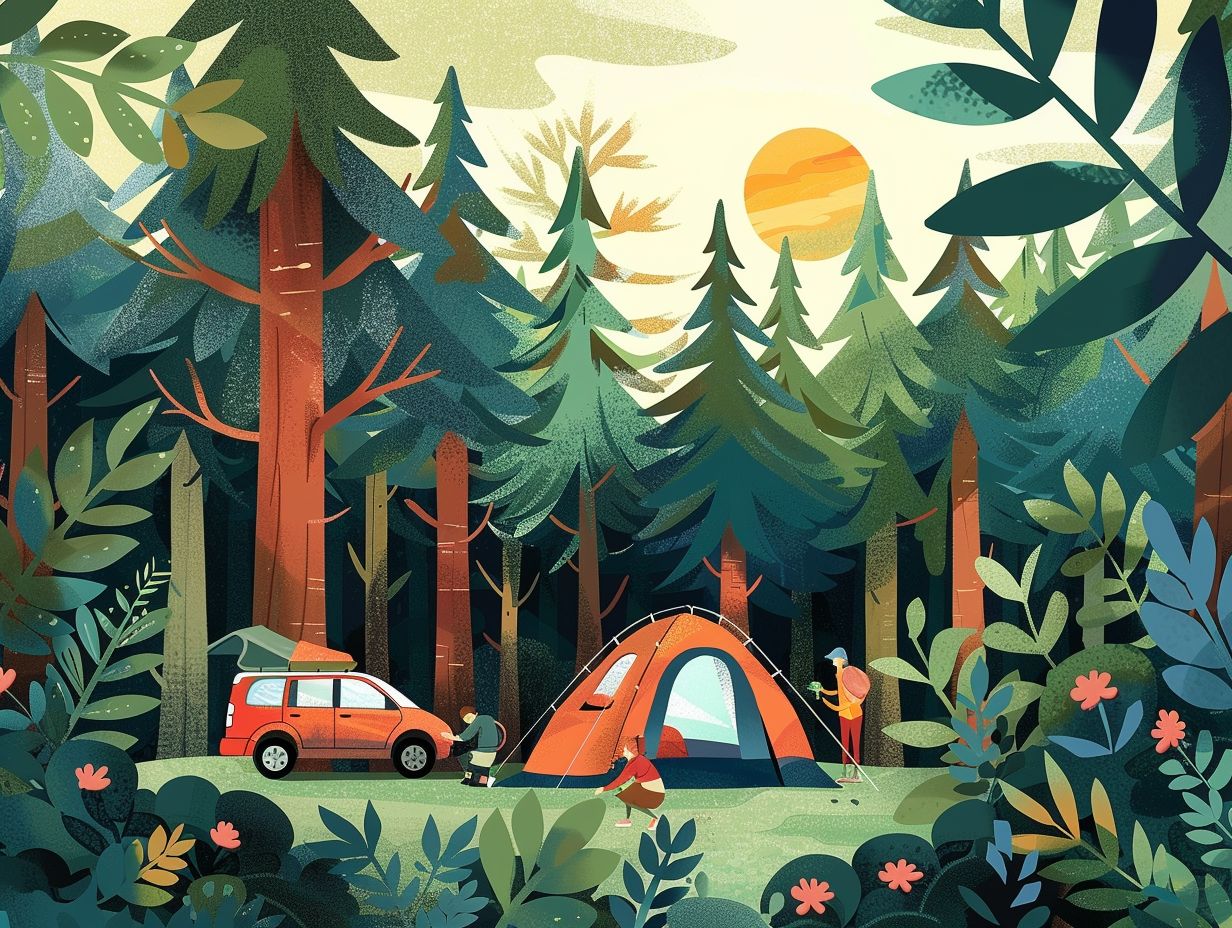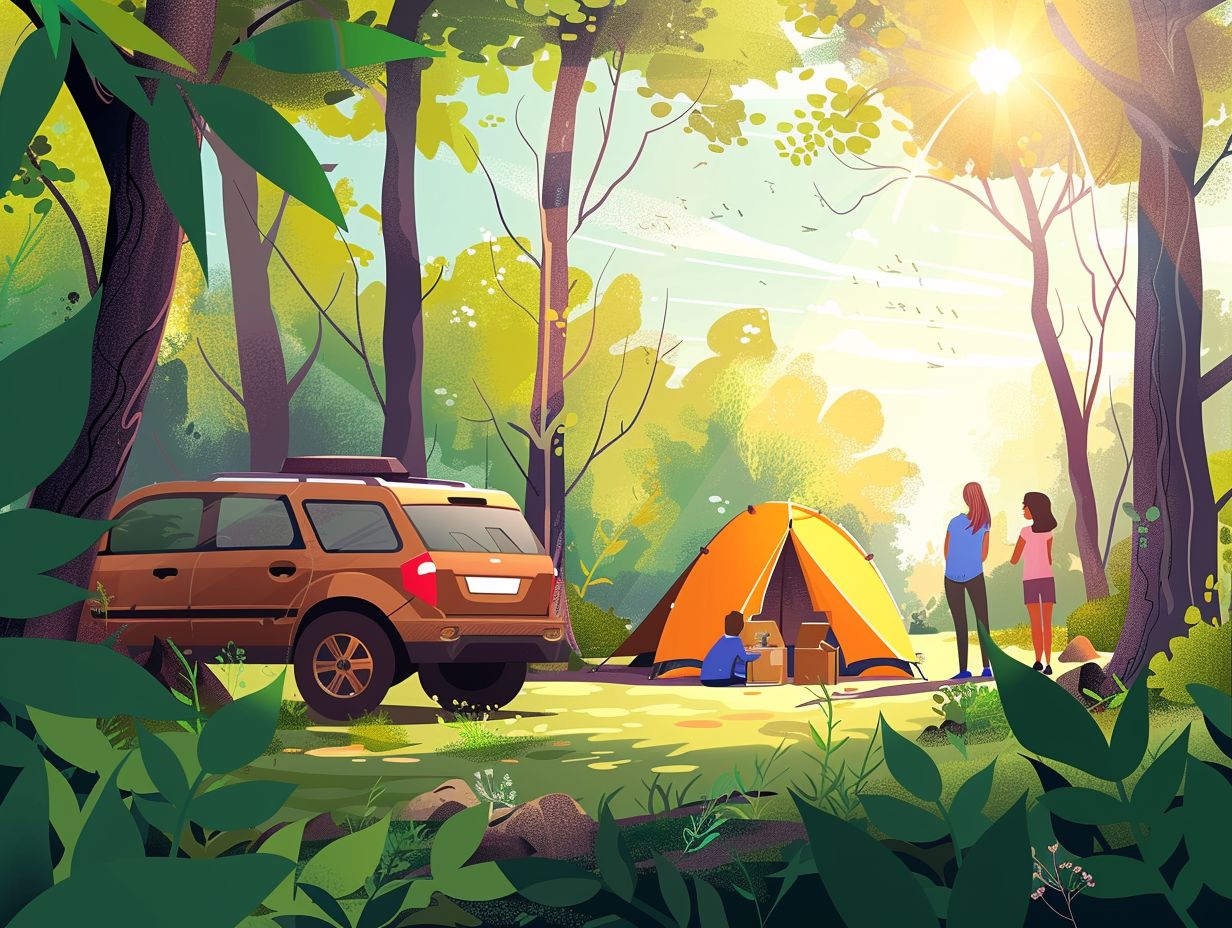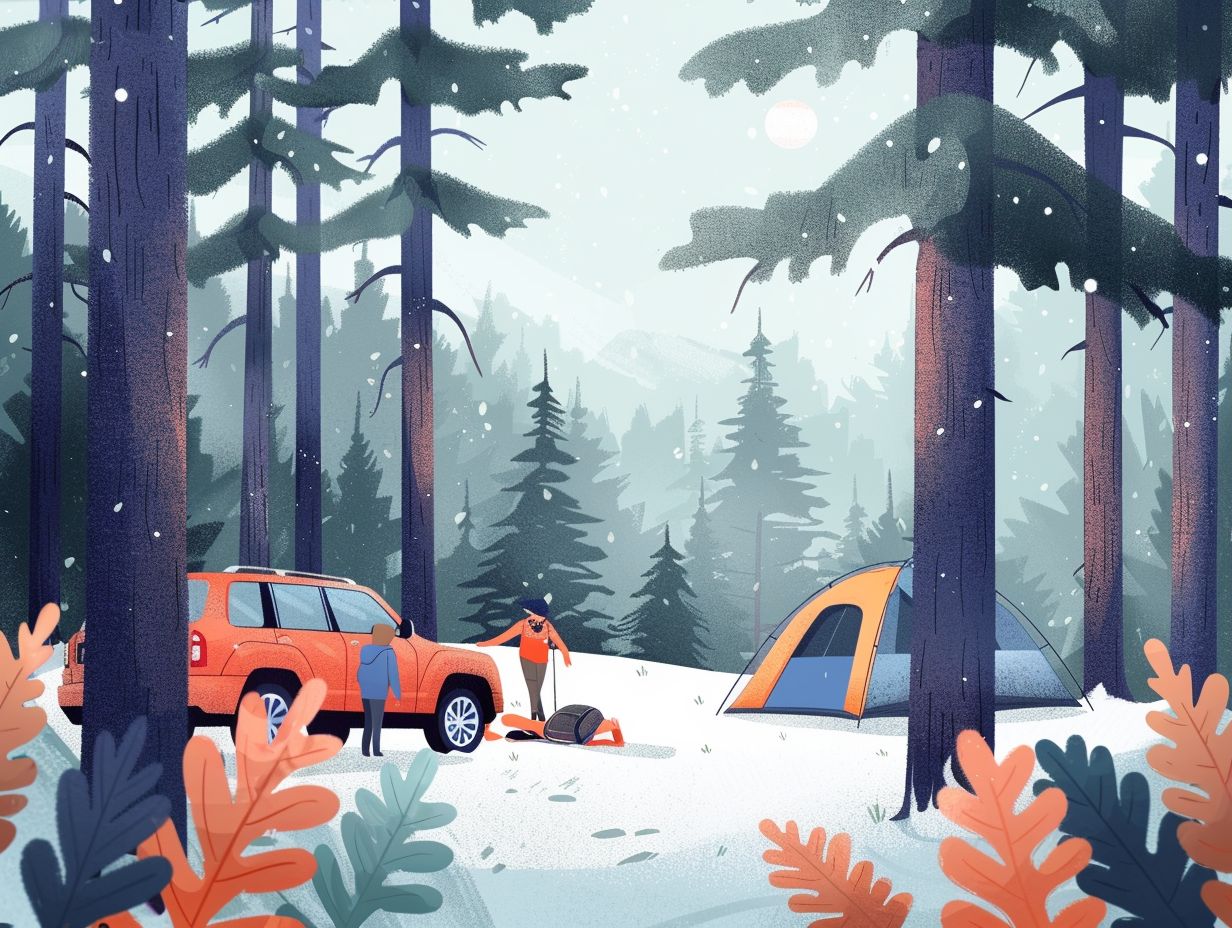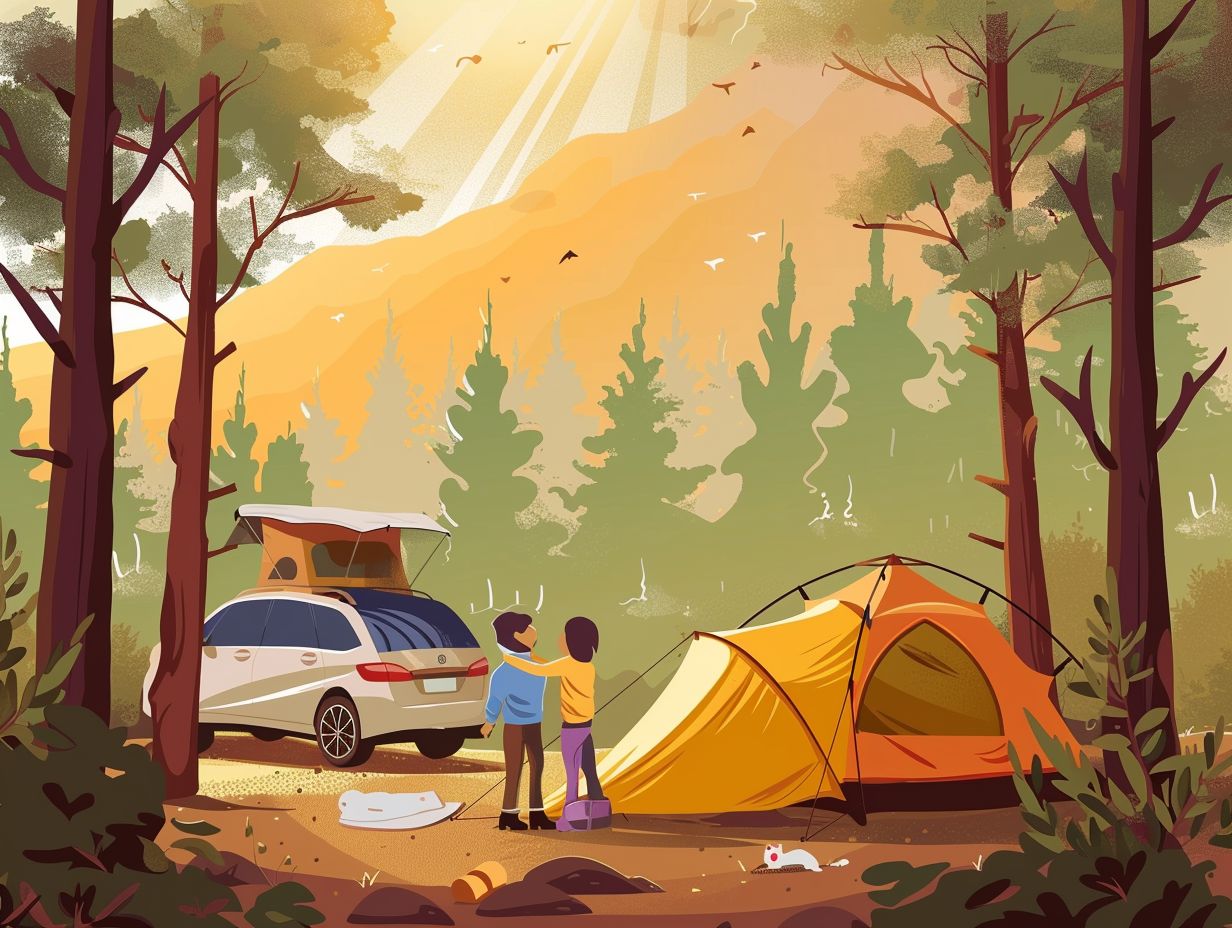When planning a car camping trip, it is crucial to consider various key tips to guarantee a successful outdoor adventure. Start by selecting the appropriate vehicle, packing essential gear, and setting up camp correctly. It is vital to familiarise yourself with campground rules, be ready for fluctuating weather conditions, and adhere to Leave No Trace principles.
By following these 15 tips, you can optimise your car camping experience and ensure that you leave the campsite in better condition than you found it.
Key Takeaways:

- Plan your route and destination carefully to make the most of your car camping trip.
- Choose a suitable vehicle for your needs to ensure a comfortable and stress-free journey.
- Pack essential gear, such as a first aid kit and weather-appropriate clothing, to be prepared for any situation on your trip.
1. Plan Your Route and Destination
Before embarking on your car camping adventure, it is crucial to plan your route meticulously and carefully select the ideal destination to ensure a seamless and enjoyable journey.
When researching potential routes, you may discover hidden gems and scenic detours that could enhance your overall experience. By taking into account local attractions and state parks along the way, you can customise your trip to include activities and sights that align with your interests.
Planning for necessary stops or detours will ensure that you are ready for any unexpected delays or worthwhile side trips. Selecting a destination that aligns with your camping preferences, whether it be a secluded wilderness location or one with recreational amenities, can enhance your outdoor experience and create lasting memories.
2. Choose the Right Vehicle
When selecting the appropriate vehicle for your car camping expedition, it is vital to consider both comfort and safety in order to ensure a pleasant outdoor experience. Whether you opt for the rugged Jeep Wrangler or the versatile Subaru Forester, your choice will have a significant impact on your camping trip.
Capacity is a crucial factor to consider when deciding on the ideal camping vehicle. The Jeep Wrangler offers ample space for outdoor gear and passengers, making it a suitable choice for those who require extra room. In contrast, the Subaru Forester has a smaller footprint, making it perfect for solo or couple trips.
For those planning to explore remote campsites and challenging terrains, off-road capabilities are essential. The Jeep Wrangler’s rugged design excels in such environments, while the Subaru Forester provides a smoother ride on various road types.
Fuel efficiency is another important consideration. The Subaru Forester is often more economical for longer journeys, making it a practical choice for those who prioritize fuel efficiency.
Regarding storage options, the Jeep Wrangler’s larger cargo capacity allows for storing bulkier camping equipment. On the other hand, the Subaru Forester’s versatile interior layout offers customisable arrangements for different types of gear.
Ultimately, your choice between a Jeep Wrangler and a Subaru Forester will greatly impact the comfort and convenience of your car camping experience, depending on your specific camping needs – whether that involves off-road adventures or highway-bound trips.
3. Pack the Essential Gear
As you prepare for your car camping trip, it is important to ensure that you pack all the essential gear. This includes a cosy sleeping bag for comfortable nights under the stars and a reliable cooking stove for preparing delicious campsite meals.
A robust tent is another critical item to have, as it will shield you from the elements and provide a comfortable shelter during your outdoor adventure. Don’t overlook the importance of a quality sleeping mat to ensure a restful sleep, as well as a cool box to keep your food fresh throughout your trip.
When organising your gear in your vehicle, consider the use of storage bins to maintain a tidy and easily accessible setup. Additionally, make use of elastic cords or luggage nets to secure larger items such as tents and cool boxes in place, preventing them from shifting during transit.
4. Have a Backup Plan
It is crucial to have a contingency plan in place in case of unforeseen circumstances such as a vehicle breakdown or running out of fuel while on your car camping journey. This ensures that you are adequately prepared to face any challenges.
Carrying additional petrol, tools for minor repairs, and emergency supplies can serve as lifesaving measures when camping in remote locations or when assistance is not readily accessible.
Remaining adaptable is crucial – be prepared to adjust to changing weather conditions, road closures, or unexpected diversions by having alternate routes planned out in advance.
Being equipped with a backup plan also entails keeping a first aid kit, torch, and essential survival equipment easily accessible at all times. Remember, it is preferable to have these items on hand and not require them than to find yourself in a situation where you need them but do not have them while outdoors.
5. Familiarise Yourself with Campground Rules and Regulations

Before pitching camp, take the time to familiarise yourself with the specific rules and regulations of the campsite, especially those set by the Forest Service or local land management agencies, to ensure a harmonious and compliant camping experience.
Being aware of the guidelines regarding campfires is crucial for both safety and environmental conservation. Respect any designated fire pits and always check if fires are permitted at the campsite.
Proper disposal of waste is another key aspect to consider—take all rubbish with you, avoid littering, and follow recycling protocols if available.
Understanding how to interact with wildlife responsibly is essential to maintaining the ecosystem’s balance. Before setting off on your trip, always check for any restrictions or permits required for camping in certain areas to avoid any legal issues.
6. Arrive Early to Secure a Good Campsite
To secure the ideal campsite for your car camping adventure, you should aim to arrive early at the campsite, especially if accessing sites through Forest Service roads, to ensure you have ample options for setting up camp.
Arriving early not only increases your chances of snagging a prime camping spot but also allows you to explore the area in daylight, making it easier to scout for suitable campsites.
When you arrive early, you can savour the tranquillity of nature before the rush of other campers arrives. Make sure to keep an eye out for signs indicating designated camping areas and follow Forest Service road regulations to safely navigate your way to more secluded and picturesque camping spots.
7. Set Up Camp Properly
When setting up camp, prioritise proper tent pitching and arranging your sleeping mat for a comfortable night’s rest, ensuring a well-organised and cosy camping environment for your car adventure.
To begin, select a flat and smooth area for pitching your tent, ensuring it is free from rocks or branches that may cause discomfort. Once your tent is securely set up, place your sleeping mat on a level, debris-free spot to provide a cushioned surface for a restful sleep. When positioning your sleeping area inside the tent, consider placing it towards the rear to maximise space efficiency.
Additionally, strategically arrange your camp furniture, such as chairs and tables, within easy reach while ensuring clear pathways for convenience.
8. Practice Leave No Trace Principles
Embrace the Leave No Trace principles during your car camping trip to minimise environmental impact, especially when exploring pristine wilderness areas or backcountry locations, preserving the natural beauty for future generations.
By adhering to these core principles, you can ensure that you leave minimal traces of your presence in the outdoors.
One of the fundamental rules is to pack out all rubbish, including food scraps and cigarette ends, so that the wilderness remains unspoilt.
Another key principle is to respect wildlife by observing them from a distance and not feeding them.
Regarding campfires, opt for established fire rings or use a camping stove to minimise the impact on the environment.
These strategies can be applied in various outdoor settings, whether you are hiking, backpacking, or simply spending a day at the beach.
9. Be Prepared for Changing Weather
Prepare for fluctuating weather conditions during your car camping expedition by packing versatile gear that can handle various elements, ensuring you remain comfortable and safe regardless of the forecast. Weather forecasts are crucial tools to help you plan ahead and anticipate any sudden changes.
Before setting off, check multiple sources to get a comprehensive understanding of the weather patterns in the area you’ll be camping.
Along with packing appropriate clothing layers, consider bringing extra waterproof gear to shield yourself from unexpected rain showers. When setting up camp, look for natural windbreaks and level ground to maximise comfort.
Always have a backup plan in case weather conditions intensify, and be prepared to adjust your itinerary as needed to stay safe and enjoy your outdoor experience.
10. Keep Food and Trash Secure

To maintain a safe and clean campsite, it is crucial to adhere to proper food storage and rubbish disposal practices. Utilise bear-proof food lockers, especially in grizzly country, to prevent wildlife encounters and ensure the camping area remains free from hazards.
By implementing these measures, not only are you safeguarding animals from developing a dependence on human food, but you are also promoting the well-being of both campers and wildlife.
By securely storing food in bear-proof containers and disposing of rubbish properly, you are effectively reducing the likelihood of attracting bears and other wildlife to your campsite.
Additionally, remember to minimise cooking odours by promptly cleaning up after meals and refraining from cooking near sleeping areas.
Avoid bringing scented toiletries or other fragrant items that may pique the interest of wildlife. By adhering to these guidelines, you can foster a more harmonious relationship with the natural environment while enjoying your camping experience.
11. Stay Safe from Wildlife
When embarking on a car camping trip, particularly in grizzly country, it is essential to prioritize wildlife safety measures. By adhering to guidelines for bear encounters, securing food properly, and respecting wildlife habitats, you can guarantee a harmonious coexistence in natural settings.
When entering areas inhabited by bears, it is vital to bear in mind that these are wild creatures and should be approached with caution and respect. An important practice is to store food in bear-proof containers or hang it high in a tree away from your campsite to deter bears from being attracted to it.
Creating noise while hiking, particularly in dense vegetation or near water sources, can alert bears to your presence and reduce the likelihood of unexpected encounters. Show respect for the animals’ territory by maintaining a safe distance and observing quietly from afar to avoid disrupting their natural behavior.
By following these safety measures, you not only decrease the chances of conflicts but also play a role in preserving wildlife habitats during your camping excursion.
12. Bring Activities for Entertainment
Enhance your camping experience by including a variety of entertainment activities in your plans, ranging from outdoor games to a good bedtime novel.
By ensuring you have enjoyable pastimes available, you can unwind and build connections with your fellow campers. Engaging in activities such as board games can foster a sense of friendly competition and create enduring memories in the midst of the starry night.
For a more serene experience, consider exploring the nearby hiking trails to completely immerse yourself in nature’s beauty and uncover hidden treasures along the journey. Stargazing provides a tranquil opportunity to marvel at the vastness of the universe, offering a sense of wonder and awe.
Remember the enchantment of storytelling around a crackling campfire, where imaginations are set free, and bonds are strengthened through shared narratives. Such moments can truly elevate your camping experience to something unforgettable.
13. Don’t Forget to Bring a First Aid Kit
Prioritise your safety during your car camping adventure by ensuring you have a comprehensive first aid kit packed with essential medical supplies. This will allow you to effectively handle emergencies or injuries that may arise, providing you with peace of mind especially when in remote locations.
Include the following items in your first aid kit:
- Adhesive plasters of various sizes
- Dressings
- Antiseptic wipes
- Adhesive tape
- Plaster pads
- Scissors
- Tweezers
- Painkillers
- Antihistamines
- Any specific medications you may require
Additionally, remember to carry crucial emergency contact information, such as your personal details, emergency contacts, and any relevant medical conditions or allergies. Customise your first aid kit according to the planned activities, considering factors like the duration of your trip and the proximity to medical facilities.
14. Have a Plan for Waste Disposal
To maintain campsite cleanliness and uphold environmental stewardship, you should implement a waste disposal plan. Utilise methods such as WAG bags or designated waste disposal areas to minimise impact and adhere to responsible camping practices.
When managing human waste in outdoor settings, it is crucial to adhere to Leave No Trace principles. This includes packing out all rubbish, including toilet paper, and disposing of waste in designated facilities whenever possible.
Proper disposal of rubbish and waste is essential for protecting the natural habitats being explored. Incorporating biodegradable products and reducing the use of single-use items can greatly decrease the environmental impact of camping excursions.
Leave the Campsite Better Than You Found It

Adopt a mindset of campsite preservation and environmental stewardship by leaving the camping area in better condition than you found it so future visitors can enjoy the same pristine beauty of the outdoors.
This involves not only cleaning up after yourself but also going the extra mile by picking up any litter left behind by others, properly dismantling fire rings, and returning disturbed natural elements such as rocks and plants to their original places.
By embracing this sense of individual responsibility, each camper contributes to the collective effort of preserving the integrity and ecological balance of these shared outdoor spaces.
Frequently Asked Questions
What are some essential items to bring on a car camping trip?
Some essential items to bring on a car camping trip include a tent, sleeping bags, a camp stove, cooking utensils, a first aid kit, and a map or guidebook.
How can I ensure a comfortable night’s sleep while car camping?
To ensure a comfortable night’s sleep while car camping, make sure to bring a sleeping pad or air mattress, extra blankets for warmth, and a pillow to provide support for your neck.
What are some safety precautions to take when car camping?
Some safety precautions to take when car camping include properly storing food to prevent attracting animals, having a first aid kit on hand, and following all local rules and regulations for the campsite.
How can I save money on a car camping trip?
To save money on a car camping trip, consider sharing the cost of supplies and gas with other campers, bringing your own food instead of eating out, and choosing a campsite with lower fees or free camping options.
What are some tips for setting up a campsite?
To set up a successful campsite, choose a flat and level area, make sure to have proper ventilation for your tent, and set up a designated cooking and eating area away from your tent to avoid attracting animals.
What should I do with my trash while car camping?
It is important to properly dispose of all trash while car camping to prevent harm to the environment and wildlife. Bring trash bags and designated containers to properly contain and dispose of your trash.



